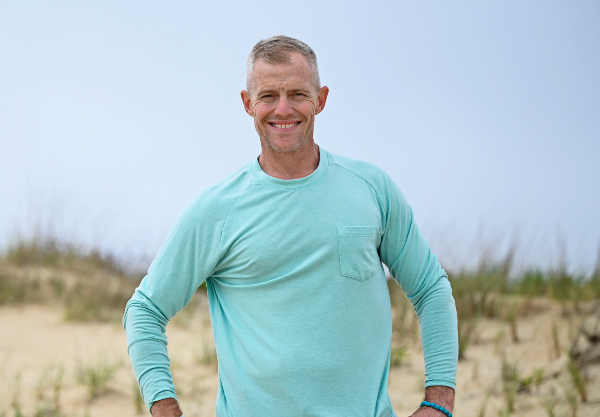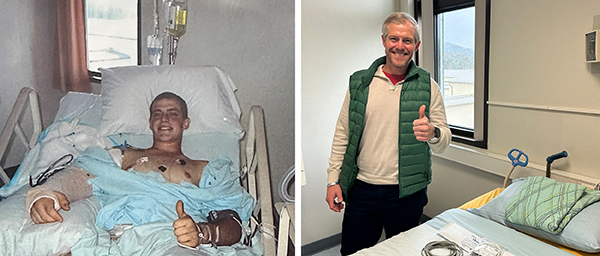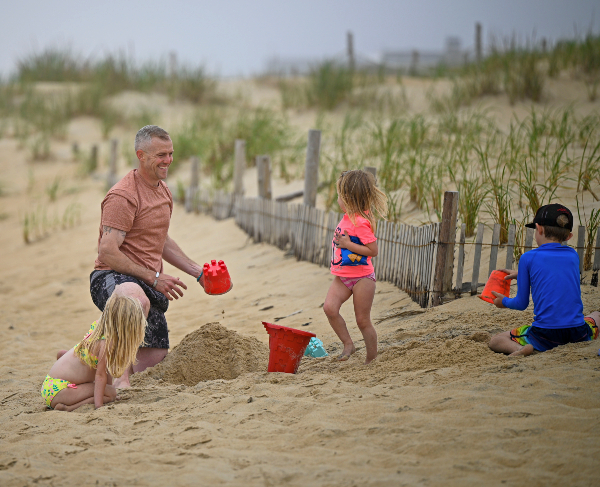Army Ranger Gives Thumbs Up After Surviving Building Collapse

How Army Ranger John Rego’s Physical and Mental Healing Journey Came Full Circle
John Rego joined the Army after high school. His first day of boot camp was September 7, 2001. Four days later, a massive attack on the U.S. took place and changed the course of this nation’s history and the lives of many recruits.
John had decided he wanted to be an Army Ranger before September 11, but after, his purpose was more resolute. “There was no way I was going to be anything besides a Ranger,” said John.
The Maryland native’s father and stepfather were working at the Pentagon as contractors on September 11, and both survived. John’s personal ties gave him a determination that would carry him through basic training, airborne school, and specialized Army Ranger training.
John graduated with honors, and he remembers telling himself, “I will never allow myself to fail because I want those guys to be at my left and right when I have to go to combat. It [gave me] a sense of honor to be included with these guys who had been through this training.”
John was in the same unit that was previously involved in the Battle of Mogadishu in the movie Black Hawk Down, and he was mindful that those who served with him were there because they wanted to be there. “The Ranger motto is Sua Sponte, meaning of their own accord,” John said.
If he had not been critically injured in Iraq, John says he would have been a Ranger of his own accord for the rest of his career. He had a solid commitment to the tough things Rangers do.
“Even when we were cold and wet and miserable and hadn’t slept for three days, we would just look at each other and laugh. We just kept going. Even the worst parts were the greatest parts.”
Tried and True Grit
John and his unit deployed to Afghanistan in 2002 and then to Iraq in 2003. They fought in Iraq in the Battle of Haditha Dam, which involved six straight days of fighting around the clock, taking in almost constant mortar fire.
After a tank unit arrived to relieve them and the dam had been secured, John and his unit were sent to make sure no enemy vehicles could approach the secured dam. They were west of Haditha when they found a weapons cache that had been supplying the enemy during the battle. Their mission was to clear that building.
As the unit went through the building, a section that had taken artillery fire collapsed, bringing the whole structure down on top of John. His unit rushed to dig him out and save his life.
“It was an all-concrete structure with steel beams,” John recalled. “It buried me alive. Luckily, I was the only one inside the building. The other guys were off to the side. When it came down, they were able to get out with only minor injuries. I was the only one who was pretty much crushed and buried.”
His battle buddies spent time digging through the rubble until they found him. They resuscitated him twice, and they got him on his way to a field hospital, then to Kuwait, then to Landstuhl Regional Medical Center in Germany.
A Long Recovery

At Landstuhl Regional Medical Center, John was intubated and could only move his left hand. Still, he was able to point at letters to ask whether anyone else had been injured. He gave doctors and nurses a thumbs up and asked whether he had lost any limbs. “I thought there was no way I could have made it out and not lost something.” John said. Fortunately, he did not need any amputations, despite severe injuries and multiple broken bones.
John’s right arm was broken in several places, he battled a bacterial infection, and endured more than 30 surgeries, losing two-thirds of his triceps muscles. He had broken ribs, a broken pelvis, and a hip replacement. He had traumatic brain injury (TBI) and also a fractured skull. He had abdominal injuries, including a ruptured stomach, intestines, and bladder.
He would spend the next year at Walter Reed National Medical Center, which was closer to his home and to his parents, who visited daily. He managed post-traumatic stress disorder (PTSD) in addition to the challenges of his physical recovery.
For John, the hardest thing was learning to reimagine life without his identity as an Army Ranger. John was thankful to be alive but felt that he had lost his purpose. He wanted to be a Ranger again.
“I had that mentality of ‘there’s no other option in life besides being a Ranger,’” John said. “I went from being the most in shape, toughest guy, to the most difficult realization that I am never going to be the guy I once was. That beat me up emotionally.”
Connecting with Veterans Who ‘Know the Feeling’
“I had destructive habits. I was drinking too much and isolating myself from others. A lot of it was that I felt sorry for myself, and I was mad that I wasn’t with my guys who I felt needed me. But a lot changed when Wounded Warrior Project reached out to me.”
John participated in Wounded Warrior Project® (WWP)’s Physical Health and Wellness programs, where he discovered that working on his physical wellness led to mental wellness.
Through WWP, John met other veterans with similar experiences. “They had the same feelings I had about being separated from the military and what we felt we were meant to do,” John said.
“And we just worked out together. It was so cool that I was just working out with other veterans.”
Soon, John realized that, with the support of his new network of veterans, he was capable of overcoming much more. “I lost close to 60 pounds in two months. I stopped drinking, and at that time, I was on medications for anxiety, anti-inflammatories for arthritis, and pain medication. All of a sudden, I realized I didn’t need any of them.”
John was able to envision new goals for himself. At first, it was physical goals, which were impressive considering everything his body had been through.
“I stopped having horrible, debilitating arthritis in my arm, which I thought was going to be with me for the rest of my life,” John said. “I started sleeping better. I started having better relationships and feeling happier. And I thought, ‘this is unbelievable.’ I fell in love with the sense of camaraderie that I had in the military. I was getting that again from Wounded Warrior Project.”
John continued in WWP physical wellness programs, had an opportunity to do Soldier Ride in D.C., and also joined WWP peer support mentoring, helping other warriors make the same connections that had benefitted him.
“It’s great to have a bunch of people with whom you can let your guard down and have an opportunity to be vulnerable,” John said. “With peer support, you can open up a little bit more. I don’t talk with my wife about some of the things that I talk about with other peers. They just know the feeling.”
An Injured Warrior Becomes the Best Man He Can Be
In Spring 2023, WWP invited John on a resiliency trip to Germany for the 70th anniversary of Landstuhl Regional Medical Center. The trip also marked 20 years since John’s combat injuries and medevac through Landstuhl.

“This trip gave me the opportunity to get closure from how I originally left Iraq, which wasn’t on my own terms, and get a chance to thank the staff who work to save the lives of our injured servicemen and women,” John said.
While there, he shared his story with active-duty service members and connected with a surgeon who knows the staff who operated on John and who had other connections to his Ranger unit.
“Being there gave me a true appreciation for everything good that’s going on in my life now and allowed me to tie those good things back to individuals who went above and beyond to save me and help me have a good life,” John said.
“Having Wounded Warrior Project reach out to me and give me the opportunity to get closure on the process, from having been injured on the battlefield all the way to my recovery at home, and tying it together gives me a feeling of overall well-being.”
Today, John is a general manager of a business, a father of three young children, and a mentor to other veterans. He continues to participate in WWP programs and introduce other warriors to the physical and mental healing he found.
“It took me a while to realize that I’m never going to be the guy I was in the military,” John said. “But I can use what I have to work with to become the best man I can be.”
Learn more about how veterans are living full lives and helping others combat the stigma associated with PTSD.
Contact: Raquel Rivas — Public Relations, rrivas@woundedwarriorproject.org, 904.426.9783
About Wounded Warrior Project
Since 2003, Wounded Warrior Project® (WWP) has been meeting the growing needs of warriors, their families, and caregivers — helping them achieve their highest ambition. Learn more.